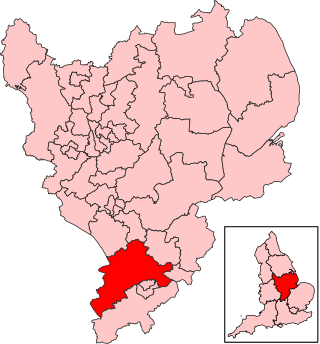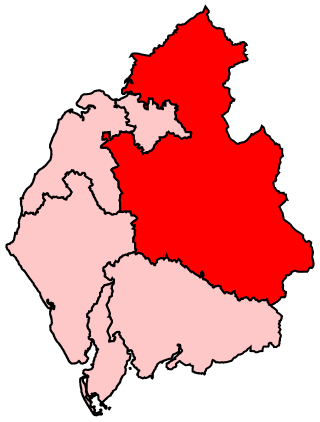Related Research Articles

Cumberland is an area of Northern England which was historically a county. It is bordered by the historic counties of Northumberland to the north-east, County Durham to the east, Westmorland to the south-east, Lancashire to the south, and the Scottish counties of Dumfriesshire and Roxburghshire to the north. The area includes the city of Carlisle, part of the Lake District and North Pennines, and the Solway Firth coastline.

Carlisle is a constituency in Cumbria represented in the House of Commons of the UK Parliament since 2024 by Julie Minns of the Labour Party.

Daventry is a constituency in Northamptonshire represented in the House of Commons of the UK Parliament since 2024 by Stuart Andrew of the Conservative Party.

Penrith and The Border was a constituency in Cumbria represented in the House of Commons of the UK Parliament. It elected only members of the Conservative Party since its creation in 1950.

Gainsborough is a constituency in Lincolnshire represented in the House of Commons of the UK Parliament since 1983 by Sir Edward Leigh of the Conservative Party, who, since the 2024 general election, is the Father of the House.
East Grinstead was a parliamentary constituency in the Kingdom of England, the Kingdom of Great Britain, and the United Kingdom. It first existed as a Parliamentary borough from 1307, returning two Members of Parliament to the House of Commons elected by the bloc vote system. The borough was disfranchised under the Reform Act 1832, but the name was revived at the 1885 election when the Redistribution of Seats Act created a new single-member county division of the same name.
Epping was a parliamentary constituency represented in the House of Commons of the UK Parliament from 1885 to 1974. It elected one Member of Parliament (MP) by the first past the post system of election.
Buckrose was a county constituency of the House of Commons of the Parliament of the United Kingdom, comprising the northern part of the East Riding of Yorkshire, represented by one Member of Parliament, and was created for the 1885 general election.

Darwen was a county constituency in Lancashire, centred on the town of Darwen. It returned one Member of Parliament to the House of Commons of the Parliament of the United Kingdom from 1885 until it was abolished for the 1983 general election.
Torquay was a county constituency in Devon, South West England, which returned one Member of Parliament to the House of Commons of the Parliament of the United Kingdom.

Westmorland was a constituency covering the county of Westmorland in the North of England, which returned Members of Parliament to the House of Commons of the Parliament of the United Kingdom.
Horncastle was a county constituency in Lincolnshire which returned one Member of Parliament (MP) to the House of Commons of the Parliament of the United Kingdom. MPs were elected by the first past the post system of voting.

Skipton was a county constituency centred on the town of Skipton in Yorkshire which returned one Member of Parliament (MP) to the House of Commons of the Parliament of the United Kingdom.

Cleveland was a county constituency in the Langbaurgh Wapentake, North Riding of Yorkshire, England.
Woodbridge was a county constituency centred on the town of Woodbridge in Suffolk. It returned one Member of Parliament (MP) to the House of Commons of the Parliament of the United Kingdom.
Melton was a county constituency centred on the town of Melton Mowbray in Leicestershire. It returned one Member of Parliament (MP) to the House of Commons of the Parliament of the United Kingdom.
Egremont was a parliamentary constituency centred on the town of Egremont in Cumberland. It returned one Member of Parliament (MP) to the House of Commons of the Parliament of the United Kingdom, elected by the first past the post system.
Eskdale was a parliamentary constituency centred on the Eskdale, district of north Cumberland not to be confused with the valley of Eskdale in the west of the county. It returned one Member of Parliament (MP) to the House of Commons of the Parliament of the United Kingdom, elected by the first past the post system.
East Dorset is a former United Kingdom Parliamentary constituency. It was formally known as the Eastern Division of Dorset. It was a constituency of the House of Commons of the Parliament of the United Kingdom. It was represented by one Knight of the Shire.
Penrith and Cockermouth was a parliamentary constituency centred on the towns of Penrith and Cockermouth in Cumberland, England. It was alternatively known as Mid Cumberland. It returned one Member of Parliament (MP) to the House of Commons of the Parliament of the United Kingdom, elected by the first past the post system.